
The Terminal Boredom Guide to Free Jazz, Part One
By Scott �Jazzmataz� Soriano
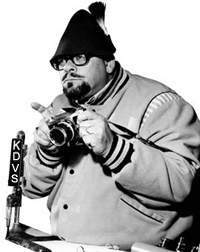 There comes a time in every weird punk�s life when the
noise generated by drums and guitars is not enough.
Sleep is interrupted by sweat-drenched panic, thoughts
racing rapid fire. �I need noise. Something different.
A new kind of intensity.� The youth will bring this
concern into a record store and confide in the beardo
behind the counter. When the beardo whispers the words
�free jazz,� the young weird punk first wonders if a
dinner invitation is to follow. Before weird punk
dismisses the beardo with a rant about junior high
jazz band, a copy of Ornette Coleman�s "Twins" is handed
to him with the advise, �Check this out. You�ll be
fine.� Perhaps this has happened to you. If not,
consider me the kindly beardo turning you on to a
whole new world of noise.
There comes a time in every weird punk�s life when the
noise generated by drums and guitars is not enough.
Sleep is interrupted by sweat-drenched panic, thoughts
racing rapid fire. �I need noise. Something different.
A new kind of intensity.� The youth will bring this
concern into a record store and confide in the beardo
behind the counter. When the beardo whispers the words
�free jazz,� the young weird punk first wonders if a
dinner invitation is to follow. Before weird punk
dismisses the beardo with a rant about junior high
jazz band, a copy of Ornette Coleman�s "Twins" is handed
to him with the advise, �Check this out. You�ll be
fine.� Perhaps this has happened to you. If not,
consider me the kindly beardo turning you on to a
whole new world of noise.
For many a young�un, the word �jazz� is pure
punkicide. That is understandable. Most of us are
introduced to jazz via school jazz bands, public
radio, and PBS. We get jazz filtered through the ears
of Ken Burns and shackled by the limitations and/or
politics of the educational system. Most of us are
lucky to get past Louie Armstrong to Charlie Parker.
Some are blessed to be lead to Thelonious Monk and
Miles Davis, but no further. It takes the chance
encounter with a very cool music teacher, an
insightful record store clerk, or the way-out older
sibling or parent (your's or a friend�s) to get turned
on to free jazz.
Before I go further perhaps I should define free jazz
and give you a little history. While the phrase �free
jazz� first came to public notice with Ornette
Coleman�s 1960 LP by that title, the music had been
brewing for a few years. However, a quote from the
album's liner notes is a good way to define
this genre of music. In the notes, Martin Williams
writes, �[Free Jazz] is a continuous free
improvisation with only a few, brief pre-set sections.
It was done in one �take� at a single recording
session. No one knew how long it would last; two tape
machines were simply kept going and when 'Free Jazz' was
over it had taken over 38 minutes - the length of an
LP. There was nothing more to play.�
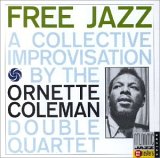
Williams continues, �Not only is the improvisation
almost total, It is frequently collective, involving
all eight men [two saxes, two trumpets, two basses, &
two drummers] inventing at once. And there were not
preconceptions as to themes, chord patterns or chorus
lengths. The guide for each soloist was a brief
ensemble part which introduces him and which gave him
an area of music pitch...Ornette Coleman put it, �We
were expressing our minds and emotions as much as
could be captured by electronics.��
Free Jazz was not received kindly by the jazz
establishment. It broke too many damn rules. No
pre-set structure? Two drummers? What about a band
leader? Critics were not comfortable with the notion
that the content could define the form of the music.
They also wrote all the sound being generated by these
guys as a bunch of noise, refusing to admit that in
order to pull of free improvisation the level of
musicianship had to be high. Free Jazz was
marginalized and written off as a fad.
Such a response was something Ornette was used to.
Touring with King Curtis�s band in the 1950s, Coleman
was routinely harassed for his odd soloing. Once he
was taken behind a club and stomped by some of the
audience and a few members of his own band. When he
moved from Texas to California, he had trouble making
the West Coast Jazz scene. When he would show up to LA
jam sessions, musicians would walk off the stage in
order to avoid playing with him. Undeterred by the
close minded, Ornette sought out like minded musicians
and trained them to play his music.
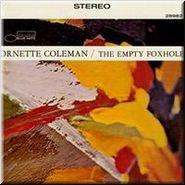
What made Ornette�s music different was that he asked
his musicians to solo off what they felt rather than
the conventions of Western music theory, scales, or
what the jazz establishment felt was right. Add a bit
of music theory to that notion and you have what
Coleman calls Harmolodics. Coleman also threw out set
song and solo lengths, standard instrumentation, even
what type of instruments were considered serious or
not (for instance, Ornette used a white, plastic sax,
while his partner Don Cherry played a pocket trumpet).
In later years, Ornette had his ten year old son play
drums on his Blue Note LP, "The Empty Foxhole". Denardo
plays with his pop to this day.
While Ornette Coleman was the first to use the phrase
that would define free jazz, whether he is the
father
of the genre is up for debate. Two other heavy weights
also deserve consideration as the father of free jazz.
Those two are Cecil Taylor and John Coltrane. I will
not elaborate here but instead refer you to John
Litweiler�s The Freedom Principle (DaCapo, 1990).
Okay, so now it is time to give you a brief guide to
some great free jazz records. Understand that there
are hundreds of great records in this genre, so this
list is not going to be exhaustive. Rather what is
below are albums that are important, great listens,
and/or good places to start for those unfamiliar with
free jazz. Also note that what is chosen reflects my
prejudices and tastes. Those into free jazz are as
uppity and opinionated as the people who argue over
punk bands. I am sure some people will have their own
list of recommendations. Happy hunting!
Ornette Coleman: "The Shape of Jazz to Come"; "Twins";
"Free Jazz"; "Ornette"; "The Empty Foxhole"; "Science
Fiction"; "Body Meta".
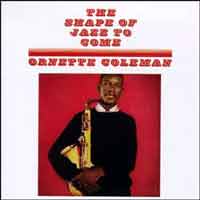 Might as well start with the man you now know a little
bit about. "The Shape..." is Ornette�s third record but
the first to really state that things from here on out
will be quite different. The soloing is a big step
away from what was going on in jazz at the time and
the song "Lonely Woman" remains one of the best songs in
any genre..."Twins" was recorded a year before "Free Jazz"
(1960) but not released until 1972. It is the first
recording of Ornette�s double quintet. In other words,
the �noise� starts here..."Free Jazz" takes the ideas
heard in "Twins" and go-go-goes with them. Notes fly by
and sound piles on top of sound. A great ride..."Ornette"
takes the intensity on "Free Jazz" and places it into a
�traditional� jazz quartet. The songs here are even a
bit more difficult than what has come before...Hard to
say if "The Empty Foxhole" is Ornette�s most radical
album but it does feature his 10 year old son on drums
and himself of trumpet and violin, two instruments he
had just started to fool around on. �Holding things
down� is bassist Charlie Haden. These three come up
with some great, if not challenging, tunes...For years,
1971�s "Science Fiction" was panned by even Ornette
fans. Finally people have started to come around. This
record has some of the group�s most intense stuff.
Songs like "Civilization Day" are blistering...Too often
overlooked is Ornette�s 1976 album "Body Meta". There
are songs on this one that are so close to No Wave
that it makes you wonder why this pup isn�t in every
weird punk�s collection already. Guitarist James Blood
Ulmer, who had a bit of a run in New York�s No Wave
scene, shines here.
Might as well start with the man you now know a little
bit about. "The Shape..." is Ornette�s third record but
the first to really state that things from here on out
will be quite different. The soloing is a big step
away from what was going on in jazz at the time and
the song "Lonely Woman" remains one of the best songs in
any genre..."Twins" was recorded a year before "Free Jazz"
(1960) but not released until 1972. It is the first
recording of Ornette�s double quintet. In other words,
the �noise� starts here..."Free Jazz" takes the ideas
heard in "Twins" and go-go-goes with them. Notes fly by
and sound piles on top of sound. A great ride..."Ornette"
takes the intensity on "Free Jazz" and places it into a
�traditional� jazz quartet. The songs here are even a
bit more difficult than what has come before...Hard to
say if "The Empty Foxhole" is Ornette�s most radical
album but it does feature his 10 year old son on drums
and himself of trumpet and violin, two instruments he
had just started to fool around on. �Holding things
down� is bassist Charlie Haden. These three come up
with some great, if not challenging, tunes...For years,
1971�s "Science Fiction" was panned by even Ornette
fans. Finally people have started to come around. This
record has some of the group�s most intense stuff.
Songs like "Civilization Day" are blistering...Too often
overlooked is Ornette�s 1976 album "Body Meta". There
are songs on this one that are so close to No Wave
that it makes you wonder why this pup isn�t in every
weird punk�s collection already. Guitarist James Blood
Ulmer, who had a bit of a run in New York�s No Wave
scene, shines here.
John Coltrane: "Giant Steps"; "Ascension"; "Kulu Se Mama"; "A
Love Supreme"; "Sun Ship"; "Live at the Village Vanguard
Again"; "Infinity"; "Interstellar Space".
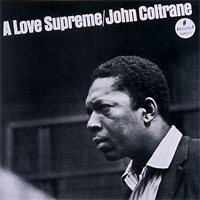
Lots of Coltrane on this list and that is because he
made a lot of records. In 1965 alone he was to record
enough to see 19 LPs released. "Giant Steps", released
in 1960, isn�t a free jazz record; however it is the
record in which Coltrane�s technique - called 'Sheets
of Sound' due to the machine gun like pace of his
solos, hundreds of notes falling over each other
creating layers of sound, yet still sounding
intelligible - is best heard and is the root of his
free jazz explorations..."Ascension" is where many people
peg the start of Coltrane�s free jazz (and for some
the beginning of the genre). "Ascension" sees �trane with
a big group, and also like Coleman�s, one that has
little direction other than what he hears other play
and a few themes used to introduce soloists. The
players on "Ascension" read like a who�s who of free
jazz. Archie Shepp, Pharoah Sanders, Marion Brown.
John Tchicai all play on it. Like the title suggests,
the piece builds and builds into a very dense and
intense splash of sound. There are two versions of
this and both are worth tracking down..."Kulu Se Mama" is
built from two sessions (many Coltrane records are a
hodge podge of recordings). One side is stripped down
but has some wonderful free playing. The title cut is
a but more filled out..."A Love Supreme" is perhaps
Coltrane�s most famous work and a great example of
both free and structured playing. It also signals
�trane�s dive into the spiritual. Books have been
written about this record so I won�t insult you with a
few lines. Just pick up this record. It is one of the
most accessable jazz records made. If it doesn�t hook
you, this might not be your thing...On "Sun Ship"
Coltrane�s classic quartet just goes for it. "Sun Ship"
is one of my favorite of Coltrane�s �noisy�
records...His "Live at the Village Vanguard" released in
1961 is one of the great jazz records...Again was
recorded four years latter and it is equal to the
first. It shows Coltrane with a new band. Gone is the
explosive Elvin Jones and in his place is Rashied Ali,
a much more subtle and difficult player than Jones,
but not lacking at all. Also sitting in are Pharoah
Sanders, Alice Coltrane, and, from his old quartet,
Jimmy Garrison. Coltrane�s soling here is among his
most emotional. At times it sounds like the sax is
crying..."Infinity" is another of my favorites. Released
after Coltrane died and cobbled together from a few
sessions, it is one of the most spiritual of his
records. Alice Coltrane�s harp figures prominently
here...One of Coltrane�s last recordings was a series of
duets with Rashied Ali released as "Interstellar Space".
If you needed �trane stripped down, here it is.
Cecil Taylor: "Nefertiti, the Beautiful One Has Come";
"Unit Structures"; "Conquistador"; "The Great Concert";
"Silent Structures"; "For Olim".
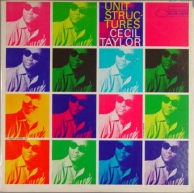 Cecil Taylor is the third person credited with
inventing free jazz. After playing with Steve Lacy,
Coltrane, and others, Taylor formed his own group and
threw out structure all together. The first recording
to capture his free jazz was made in 1962 and features
Jimmy Lyons and Sunny Murray, two free jazz giants
themselves. "Nefertiti..." wasn�t released until the 1970s
and is a flawed recording. However it has great
moments and is fairly easy to track down...The most well
known and often thought of as the best record Taylor
made is "Unit Structures". Henry Grimes, Alan Silva, &
Andrew Cyrille play on this one and make some of the
greatest racket you will ever hear..."Conquistador" is
more by the same band...If you want to earn your wings,
track down "The Great Concert" (AKA "Nuits de la
Fondation Maeght"). This 1967 triple album has Taylor,
Lyons, Cyrille and Sam Rivers jamming for about two
hours straight. Some of the piano work is so violent,
you wonder if Taylor left the keys shattered...Recorded
in 1974, "Silent Tongues" sees Taylor solo and Cecil by
himself is as intense as with a group...Another great
solo work is "For Olim". Released in 1986, it shows
Taylor is just as challenging as he was in 1962. There
are many more Taylor records to chose from and he
still makes good ones. He also continues to play live
and his concerts are full of energy and challenges.
Cecil Taylor is the third person credited with
inventing free jazz. After playing with Steve Lacy,
Coltrane, and others, Taylor formed his own group and
threw out structure all together. The first recording
to capture his free jazz was made in 1962 and features
Jimmy Lyons and Sunny Murray, two free jazz giants
themselves. "Nefertiti..." wasn�t released until the 1970s
and is a flawed recording. However it has great
moments and is fairly easy to track down...The most well
known and often thought of as the best record Taylor
made is "Unit Structures". Henry Grimes, Alan Silva, &
Andrew Cyrille play on this one and make some of the
greatest racket you will ever hear..."Conquistador" is
more by the same band...If you want to earn your wings,
track down "The Great Concert" (AKA "Nuits de la
Fondation Maeght"). This 1967 triple album has Taylor,
Lyons, Cyrille and Sam Rivers jamming for about two
hours straight. Some of the piano work is so violent,
you wonder if Taylor left the keys shattered...Recorded
in 1974, "Silent Tongues" sees Taylor solo and Cecil by
himself is as intense as with a group...Another great
solo work is "For Olim". Released in 1986, it shows
Taylor is just as challenging as he was in 1962. There
are many more Taylor records to chose from and he
still makes good ones. He also continues to play live
and his concerts are full of energy and challenges.
Okay so what is there after the big three? Plenty. But
you will have to wait �til the next update for those
cats.
The following records have been out for sometime, are
or have been available on CD, and many have been
reissued ad nauseum. If you cannot find them at your
local used record hut, finding them used via internet
auctions, record dealer sites, or mail order is not
difficult. If you are reading this I am sure you know
what an internet auction site is.
Got a city, time period, region, label, genre or whatever that you think we need to do a field guide to? Think you can do it yourself? Send all requests and submissions to termibore-at-aol-dot-com, we're always looking for quality help.
To check out past TB Field Guides go here.
PREVIOUS PAGE � HOME � NEXT PAGE
|

